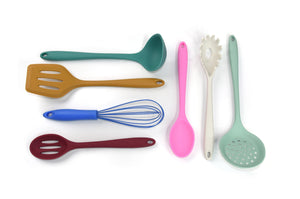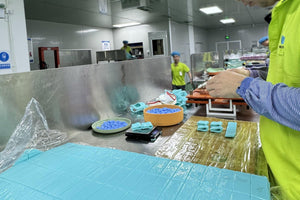Silicone kitchen tools have revolutionized the way we cook, bake, and prepare food. With their unique combination of functionality, durability, and safety, they have become a staple in modern kitchens worldwide. But what exactly sets silicone kitchen tools apart from their metal, wood, or plastic counterparts? Let’s dive into the science and features that make silicone kitchen tools a superior choice.
Understanding Silicone as a Material
Silicone is a synthetic polymer made from silicon, oxygen, carbon, and hydrogen. Unlike natural materials like wood or metals, silicone is man-made and engineered to combine flexibility, heat resistance, and non-reactivity. It is widely used in various industries, including medical, automotive, and food, due to its exceptional properties.
Key Features That Differentiate Silicone Kitchen Tools
1. Heat Resistance
-
Why It Matters: Silicone tools won’t melt or deform when exposed to hot pans, boiling liquids, or oven temperatures. This makes them ideal for cooking, baking, and even direct contact with stovetop cookware.
2. Non-Stick Properties
Silicone is inherently non-stick, meaning food residue slides off easily without clinging to the surface.
-
Why It Matters: Silicone tools are perfect for stirring, flipping, or scraping, as they won’t scratch non-stick cookware and require minimal effort to clean. This feature also makes silicone bakeware highly desirable for cakes, muffins, and other baked goods.
3. Durability and Longevity
Unlike plastic, silicone does not warp, crack, or degrade over time. It is highly resistant to wear and tear, even with frequent use.
-
Why It Matters: Investing in silicone tools means fewer replacements over time, saving money and reducing waste. Additionally, silicone’s flexibility ensures it retains its shape, even after years of use.
4. Non-Toxic and Food-Safe
High-quality silicone kitchen tools are made from food-grade or medical-grade silicone, ensuring they are safe for use in food preparation. Silicone is non-toxic, BPA-free, and does not leach chemicals into food.
-
Why It Matters: Unlike some plastics that may release harmful chemicals when heated, silicone remains stable and inert, providing peace of mind during cooking.
5. Flexibility and Softness
Silicone’s pliability allows it to bend and flex without breaking. This makes it ideal for spatulas, scrapers, and molds that need to conform to various shapes.
-
Why It Matters: Flexible silicone tools can scrape every last bit from mixing bowls or reach tight corners in cookware. Their softness also ensures they won’t scratch delicate surfaces, such as non-stick pans or glass.
6. Odor and Stain Resistance
Unlike wood or some plastics, silicone does not absorb odors, stains, or flavors from food.
-
Why It Matters: Even after prolonged exposure to strongly scented or pigmented ingredients like garlic, curry, or tomato sauce, silicone tools retain their original condition. This ensures a hygienic and neutral cooking experience.
7. Ease of Cleaning
Silicone’s non-porous surface prevents food particles from sticking or seeping in, making it exceptionally easy to clean.
-
Why It Matters: Most silicone tools are dishwasher-safe, saving time and effort. Even hand-washing requires minimal scrubbing due to their smooth and non-stick nature.
Silicone vs. Other Materials
|
|
|
|
|
|
|---|---|---|---|---|
| Heat Resistance | Up to 450°F+ | Limited | Can burn or char | Excellent |
| Non-Stick | Excellent | Moderate | Poor | Poor |
| Durability | Long-lasting | Prone to warping/ cracking |
May splinter over time |
Long-lasting |
| Safety | Non-toxic, BPA-free |
May leach chemicals |
Safe but can harbor bacteria |
Safe but reactive with acids |
| Cleaning | Easy, dishwasher-safe |
Moderate | Requires extra care |
Easy |
| Flexibility | High | Low | Low | None |
Popular Uses of Silicone Kitchen Tools
-
Spatulas and Scrapers: Ideal for scraping bowls, folding batters, and spreading frosting.

-
Baking Molds: From cupcake liners to intricate cake molds, silicone ensures easy release and detailed results.

-
Utensils: Tongs, ladles, and turners that won’t damage cookware.

-
Mats and Liners: Perfect for rolling dough, baking cookies, or protecting countertops.

Tips for Choosing High-Quality Silicone Tools
-
Look for Food-Grade Certification: Ensure the product is labeled as food-grade or FDA-approved.
-
Check for Fillers: High-quality silicone is solid and doesn’t contain fillers. A simple test is to twist the silicone—if white appears, it may contain fillers.
-
Assess Heat Tolerance: Confirm the maximum temperature rating to ensure it suits your cooking needs.
-
Choose Reputable Brands: Trusted manufacturers are more likely to offer durable and safe products.
In Conclusion
Silicone kitchen tools stand out for their unmatched combination of heat resistance, non-stick properties, durability, and safety. Whether you’re a professional chef or a home cook, incorporating silicone tools into your kitchen can elevate your cooking experience. By understanding their unique advantages and selecting high-quality products, you can enjoy the benefits of this innovative material for years to come.
About Author
We are dedicated to pushing the boundaries of possibility in silicone product manufacturing and our extensive range of inhouse designs and molds across baby, pet, homewares and more allows companies to customize and create products specific for their brand and market needs.
Whether you are looking for a company to bring your ideas and brand to life or looking for ready to go items with packaging and branding, WOLIFE is ready to help your business grow.
WOLIFE looks forward to collaborating with you!


 Using LSR in Hearing Components
Using LSR in Hearing Components Why Silicone Cooking Utensils and Baking Trays Don’t Melt – The Science Explained
Why Silicone Cooking Utensils and Baking Trays Don’t Melt – The Science Explained 10 Creative Products You Didn’t Know Could Be Made with Silicone
10 Creative Products You Didn’t Know Could Be Made with Silicone Common Quality Control Challenges in Silicone Manufacturing
Common Quality Control Challenges in Silicone Manufacturing